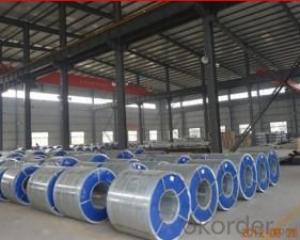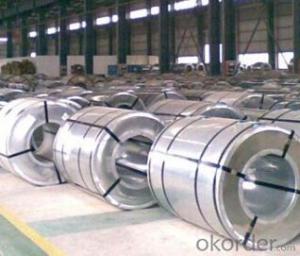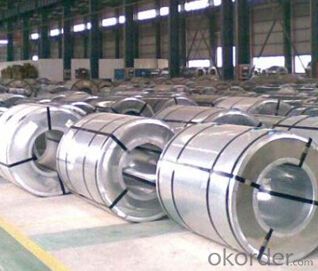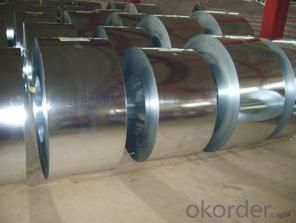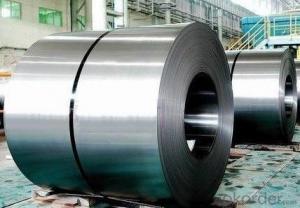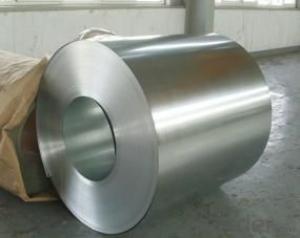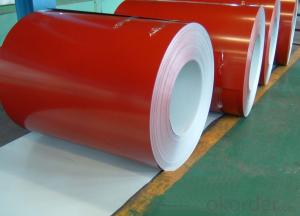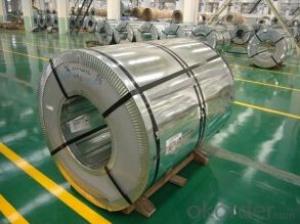Hot-Dipped Galvanized Steel Coil for Building
- Loading Port:
- Shanghai
- Payment Terms:
- TT OR LC
- Min Order Qty:
- 25 m.t.
- Supply Capability:
- 10000 m.t./month
OKorder Service Pledge
OKorder Financial Service
You Might Also Like
Basic Info.
Model NO.:Steel Coil 0005
Surface Treatment:Galvanized
Certification:ISO, SGS
Technique:Cold Rolled
Standard:ASTM, JIS, GB, AISI, DIN, BS
Application:Roof Boarding,Appliances Shell
Edge:Slit edge
Stock:Not Stock
Steel Grade:Dx51d+Z
Export Markets:Southeast Asia, Africa, Mid East, Eastern Asia
Additional Info.
Trademark:N/M OR OEM
Packing:3-5tons/Roll with Seaworthy Packages
HS Code:72104900
Production Capacity:6000tons Per Month
Product Description
Galvanized Steel Coil
Material: DX51D, DX52D, SGCC, SGCH, SPGC
Thickness: 0.13-0.7mm
Width: 750-1250mm(762mm, 914mm, 1000mm, 1200mm, 1219mm, 1250mm)
Zinc: 40g, 60g, 80g, 90, 100g, 120g, 140g, 180g, 200g, 250g, 275g and so on.
Spangle: Zero spangle, regular spangle or normal spangle
Surface treatment: Chromated and oiled, chromated and non-oiled
Packing: Export standard, plastic film+water proof paper + steel plate+ packing steel strip
Q&A
Acceptable payment term and way?
T/T,L/C, T/T + L/C, D/P
Acceptable price term
FOB CNF CIF DDU CPT
Do you accept OA payment terms?
Yes, sure, but it normally depending on the order value
Do you have QC team?
Yeah, sure, our QC team is very important, they will keep the qualitycontrol for our products.
What is the validity of your quotation?
Normally 7 days.
What is your advantage?
24 hour quick response /Customer oriented/ Credit foremost/ Top quality Excellent
What is your acceptable payment term?
TT,LC,OA etc
- Q: I know that they have steel shot in smaller sized pellets....say, number 4 shot. I guess it's for waterfowl, etc.Do they make steel buckshot? If not, why not? Would the pellets be too heavy? Wouldn't they have excellent penetration ability?
- I know of no one who makes steel buckshot. Probably for several reasons. Steel is much lighter than lead. Penetration depends on energy, which is the weight of the pellet vs. the velocity of the pellet, equated into ft.lbs. Steel pellets have to travel much faster to achieve the same energy as a lead pellet. Steel, being lighter, would lose energy much faster downrange. The weight difference would be like teeing up a golf ball, and striking it with a club, and teeing up a ping pong ball and striking it with a club. The distance in flight would be obvious. Steel also, is much harder than lead, and would be hard on the barrel, and choke. It also would not deform, which would cause ricochets. Steel shot was a handicap for waterfowler's when the USFWS made non toxic shot mandatory. Waterfowl are bottom feeders, and they were eating the spent lead pellets, and dying from lead poisoning. Steel shot cut the effective range of a shotgun from 45 yards to around 35, and resulted in many cripples and lost birds. Environmetal, makes a T size shot which is .20 caliber, and is called Hevi-shot. Lead is heavier than steel, and Hevi-shot is heavier than lead. At the same velocity, you have 12 to 15% more energy than lead. and probably 20% better than steel....Hope this helps
- Q: How do steel coils contribute to structural integrity in buildings?
- Steel coils contribute to structural integrity in buildings through their strength and durability. By using steel coils in the construction of beams, columns, and other load-bearing components, buildings can withstand heavy loads, resist deformation, and maintain their stability over time. The high tensile strength of steel coils allows for the creation of lightweight yet sturdy structures, ensuring the overall safety and longevity of the building. Additionally, steel coils offer excellent resistance to corrosion, fire, and extreme weather conditions, further enhancing the structural integrity of buildings.
- Q: What are the challenges in coil slitting?
- Coil slitting, also known as coil cutting, involves the process of cutting large metal coils into narrower strips. However, there are several challenges associated with this process. One challenge is maintaining precision during slitting, as any deviation can result in uneven strip widths or poor edge quality. Another challenge is managing the tension of the coil throughout the slitting process to prevent material distortion or breakage. Additionally, handling and transporting the slit coils can be challenging due to their length and weight. Overall, ensuring accuracy, maintaining proper tension, and effectively handling the slit coils are some of the key challenges faced in coil slitting.
- Q: I have a knife with AUS8 Stainless Steel. No idea what that means. I want to know some of the best stainless steels for knifes and all you can tell me about stainless steel would be great. I was browsing google and looking at grades and had no idea what all the numbers meant. Thanks!
- Ok so listen she already likes me what should I say
- Q: How are steel coils used in the manufacturing of automotive accessories?
- Steel coils are commonly used in the manufacturing of automotive accessories due to their strength, durability, and versatility. These coils serve as the primary raw material for various components and parts used in the automotive industry. One of the most common uses of steel coils in automotive accessory manufacturing is for the production of body panels and frames. These coils are formed and shaped into the desired size and design, and then undergo various processes such as cutting, stamping, and welding to create the body panels and frames of vehicles. The high strength of steel coils ensures that the body panels and frames are sturdy enough to withstand the rigors of daily use and provide the necessary structural integrity to the vehicle. Additionally, steel coils are also used in the production of automotive suspension systems. Coil springs, which are integral components of the suspension system, are typically made from steel coils due to their ability to absorb and distribute the weight and impact of the vehicle. These coil springs contribute to a smooth and comfortable ride by providing the necessary support and shock absorption. Furthermore, steel coils are used in the manufacturing of automotive accessories such as exhaust systems, brackets, and brackets for various components. The coils are formed and shaped into the required design and then undergo processes like cutting, bending, and welding to create these accessories. The strength and durability of steel make these accessories capable of withstanding high temperatures, vibrations, and other harsh operating conditions. In summary, steel coils play a crucial role in the manufacturing of automotive accessories by providing the necessary strength, durability, and versatility required for various components and parts. From body panels to suspension systems and accessories, steel coils contribute to the overall quality, performance, and safety of automotive accessories.
- Q: I have the game of the year edition for fallout 3 but there's no mission or quest saying it's called broken steel so what is it actually called and where is it? Please describe the quest in case I mightve already done it without even knowing.
- Broken Steel fixes the original ending of the game so that you can continue past the end and continue exploring. The Broken Steel missions also take place after the original ending of the game. One way you can tell if Broken Steel is working though is if you are finding enemies added with Broken Steel (Super Mutant Overlords, Hellfire Enclave Troops, and so on), and if you can level up past level 20 and get new perks added between 20 and 30. You can even see all of these new perks any time you level up, so next time you level up, scroll down and see if there are new perks below the level 20 perks. If there are, then Broken Steel is working properly.
- Q: What are the different methods of edge camber correction for steel coils?
- Edge camber correction in steel coils can be achieved through several methods, depending on specific requirements and available equipment. Some commonly used methods include the following: 1. Mechanical tools, such as shears or slitters, are utilized for trimming the edges of the coil. This removes excess material and corrects the camber. Mechanical edge trimming is suitable for smaller coils or minimal camber. 2. Tension leveling involves passing the coil through adjustable rollers while applying tension. This elongates the steel and reduces camber. It is effective for moderate camber and commonly used for larger coils. 3. Roller leveling, similar to tension leveling, employs fixed rollers to exert pressure on the steel and flatten it. This method is preferable for thicker and heavier coils. 4. Heat straightening utilizes controlled heat to soften the edges of the coil. Once the steel becomes malleable, external force is applied to straighten the edges. Heat straightening is suitable for severe edge camber but requires specialized equipment and expertise. 5. Combination methods may be employed by combining different techniques. For instance, mechanical edge trimming may be followed by tension leveling or roller leveling to further straighten the edges. It is important to note that the choice of method depends on factors such as camber severity, coil dimensions, material properties, and available equipment. Evaluating these factors and consulting with experts is essential to determine the most suitable method for edge camber correction in steel coils.
- Q: How are steel coils used in the production of metal doors and windows?
- Steel coils are used in the production of metal doors and windows as they are the primary raw material. The coils are processed through various manufacturing techniques such as cutting, bending, and shaping to create the frames and panels of the doors and windows. The steel coils provide strength, durability, and structural integrity to the final products, ensuring long-lasting and secure doors and windows.
- Q: steel welding with ms steel iron
- Welding austenitic stainless steels to carbon and low alloy steels are established methods in the process and construction industries. Dissimilar metal welds involving stainless steels can be done using most full fusion weld methods, including TIG (Tungsten Inert Gas) and MIG (Metal Inert Gas). Weld procedures using filler (consumable) enable better control of joint corrosion resistance and mechanical properties. In selecting the weld filler, the joint is considered as being stainless, rather than the carbon steel. Over-alloyed fillers are used to avoid dilution of the alloying elements in the fusion zone of the parent stainless steel.
- Q: How are steel coils inspected for yield strength?
- Steel coils are inspected for yield strength through a process called tensile testing. In this method, a small sample is cut from the steel coil and subjected to a controlled tension until it reaches its yield point. The amount of force required to deform the sample is measured, allowing for the determination of its yield strength.
Send your message to us
Hot-Dipped Galvanized Steel Coil for Building
- Loading Port:
- Shanghai
- Payment Terms:
- TT OR LC
- Min Order Qty:
- 25 m.t.
- Supply Capability:
- 10000 m.t./month
OKorder Service Pledge
OKorder Financial Service
Similar products
Hot products
Hot Searches
Related keywords
